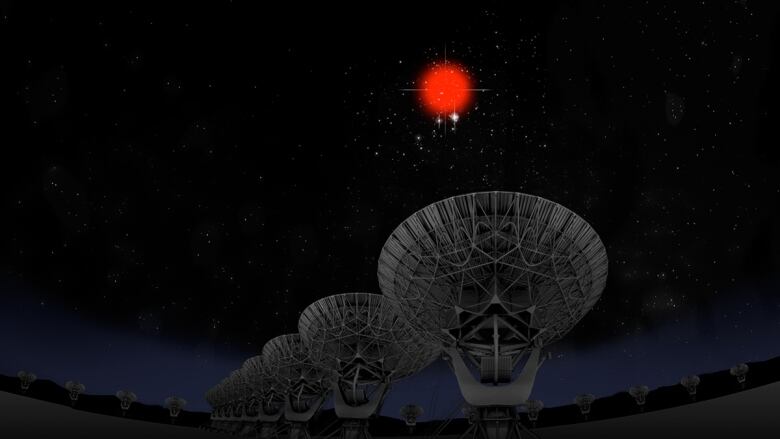Astronomers pinpoint location of fast radio burst from faint galaxy
McGill University researchers essential in discovery

Astronomers have located the source of a fast radio burst a rare and distant releaseof cosmic radio waves that lasts mere milliseconds in a galaxy more than three billion light-years from Earth.
Fast radio burstswere first discovered in 2007 using telescope data from 2001, andthey still aren't well understood.Initially, itwasn't even clear if the bursts were coming from within our galaxy or outside it. To date only 18 fast radio bursts have been discovered.
In March 2016, McGillUniversity PhD student PaulScholzfound that a previously discovered fast radio burst was repeating, which was a first.This provided an opportunity for astronomers to further study them.
In 2016, a team of Canadian and Americanastronomers seeking to locate the source of FRB 121102 observed it for 83 hours over six months. They were able to catch FRB 121102 a total of nine times.
Determining the sourcewas no easy feat: the astronomersused the National Science Foundation'sKarl G.JanskyVery Large Array (VLA) radio telescope to get a precise location in the sky. Using that data, astronomers then used the Gemini North Telescope in Hawaii to get a visible-light image of the region. They found a faint galaxy right at the heart of the outbursts, three billion light-years away.
ShriharshTendulkar, a McGillUniversity researcher and study co-author, led the Gemini research in Hawaii. He said a large part of the challenge was determining whether the source of the FRB was from a galaxy or a star. When they examined the source visually, it wasn't apparent what it was.
"It looked pretty similar to a star; it was a tiny, tiny speck of light," Tendulkartold CBC News. "The source is really faint it's100 million times fainter than the faintest object visible to the naked eye."
Using the telescope, Tendulkar and his team of researchersobserved the source using the light spectrum for about five hours, followed by almost another three hours of visible light observations.The team was able to quickly ascertain that the source was a tiny galaxy, far, far away.
Another outburst
As well as pinpointing the location, astronomers also observed a weaker, persistent radio source nearby. In order to get an even more precise location, a team used two other telescopes to conduct observations. What they found was that the two sources are within 100 light-years of one another. The scientists concluded that these bursts could be coming from the same object or that they are somehow physically associated with one another.
In order to release such intenseenergy, astronomers believe thatFRBsare caused by neutron stars small, dense stars left over after a supernova, and it's possible that the second source is related to an event like thisthat gave birth to the neutron star.
Another possibility is that FRBs are coming from a magnetar, a type of star that is similar to a neutron star, but with extremely powerful magnetic fields.
"They're probably physically related, because otherwise the chance of them being so close to each other out of coincidence is very, very low,"Tendulkar said.
Astronomers were surprised to discover that FRB 121102 was located in a dwarf galaxy these galaxies are small with few stars. Astronomers had theorized thatFRBswould be found in larger galaxies with far more stars. So this discovery has raised more questions about this relatively newly discovered phenomenon.
More Canadian involvement
This summer the Canadian Hydrogen Intensity Mapping Experiment (CHIME) is set to come online in British Columbia. This telescope could burst FRB research wide open.
"This could detect 10 to 20 FRBs per day,"Tendulkar said. When you consider that, since the first FRB discovery in2007, only 17 more have been discovered, it's an exponential growth. And, there's even a chance that it could find an FRB in our own galaxy.But the trick will be filtering out all the radio noise we put out here on Earth. Even if one isn't discovered within our own galaxy, we could find one in a galaxy that is much closer to our own.
The research was published in the journals Nature and Astrophysical Research Letters.












_(720p).jpg)


 OFFICIAL HD MUSIC VIDEO.jpg)
.jpg)



























































































